Related Research Articles

A medicine man or medicine woman is a traditional healer and spiritual leader who serves a community of Indigenous people of the Americas. Individual cultures have their own names, in their respective languages, for spiritual healers and ceremonial leaders in their particular cultures.

A sweat lodge is a low profile hut, typically dome-shaped or oblong, and made with natural materials. The structure is the lodge, and the ceremony performed within the structure may be called by some cultures a purification ceremony or simply a sweat. Traditionally the structure is simple, constructed of saplings covered with blankets and sometimes animal skins. Originally, it was only used by some of the Indigenous peoples of the Americas, notably the Plains Indians, but with the rise of pan-Indianism, numerous nations that did not originally have the sweat lodge ceremony have adopted it. This has been controversial.

Heȟáka Sápa, commonly known as Black Elk, was a wičháša wakȟáŋ and heyoka of the Oglala Lakota people. He was a second cousin of the war leader Crazy Horse and fought with him in the Battle of Little Bighorn. He survived the Wounded Knee Massacre in 1890. He toured and performed in Europe as part of Buffalo Bill's Wild West.
John Gneisenau Neihardt was an American writer and poet, amateur historian and ethnographer. Born at the end of the American settlement of the Plains, he became interested in the lives of those who had been a part of the European-American migration, as well as the Indigenous peoples whom they had displaced.

Black Elk Peak is the highest natural point in the U.S. state of South Dakota and the Midwestern United States. It lies in the Black Elk Wilderness area, in southern Pennington County, in the Black Hills National Forest. The peak lies 3.7 mi (6.0 km) west-southwest of Mount Rushmore. At 7,244 feet (2,208 m), it has been described by the Board on Geographical Names as the highest summit in the United States east of the Rocky Mountains. Though part of the North American Cordillera, it is generally considered to be geologically separate from the Rocky Mountains. Lost Mine peak in the Chisos Mountains of Texas, at an elevation of 7,535 feet, is the easternmost peak within the continental United States above 7,000 feet.
A vision quest is a rite of passage in some Native American cultures. It is usually only undertaken by young males entering adulthood. Individual Indigenous cultures have their own names for their rites of passage. "Vision quest" is an English-language umbrella term, and may not always be accurate or used by the cultures in question.
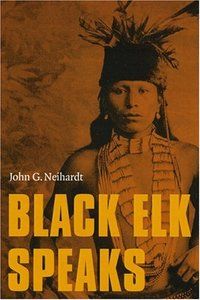
Black Elk Speaks is a 1932 book by John G. Neihardt, an American poet and writer, who relates the story of Black Elk, an Oglala Lakota medicine man. Black Elk spoke in Lakota and Black Elk's son, Ben Black Elk, who was present during the talks, translated his father's words into English. Neihardt made notes during these talks which he later used as the basis for his book.

The heyoka is a kind of sacred clown in the culture of the Sioux of the Great Plains of North America. The heyoka is a contrarian, jester, and satirist, who speaks, moves and reacts in an opposite fashion to the people around them. Only those having visions of the thunder beings of the west, the Wakíŋyaŋ, and who are recognized as such by the community, can take on the ceremonial role of the heyoka.
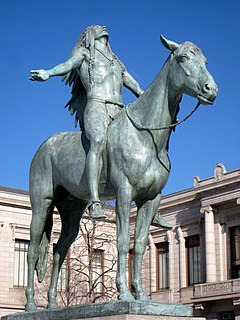
The Great Spirit is the concept of a life force, a Supreme Being or god known more specifically as Wakan Tanka in Lakota, Gitche Manitou in Algonquian, and by other, specific names in a number of Native American and First Nations cultures. While the concept is common to a number of indigenous cultures in the United States and Canada, it is not shared by all cultures, or necessarily interpreted in the same way. According to Lakota activist Russell Means, a more semantically accurate translation of Wakan Tanka is the Great Mystery.
Neoshamanism refers to new forms of shamanism. It usually means shamanism practiced by Western people as a type of New Age spirituality, without a connection to traditional shamanic societies. It is sometimes also used for modern shamanic rituals and practices which, although they have some connection to the traditional societies in which they originated, have been adapted somehow to modern circumstances. This can include "shamanic" rituals performed as an exhibition, either on stage or for shamanic tourism, as well as modern derivations of traditional systems that incorporate new technology and worldviews.
Plastic shaman, or plastic medicine people, is a pejorative colloquialism applied to individuals who are attempting to pass themselves off as shamans, holy people, or other traditional spiritual leaders, but who have no genuine connection to the traditions or cultures they claim to represent. In some cases, the "plastic shaman" may have some genuine cultural connection, but is seen to be exploiting that knowledge for ego, power, or money.
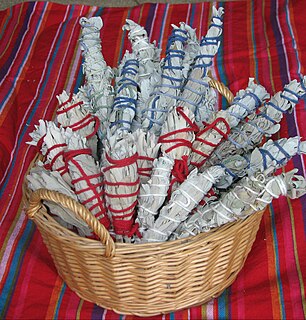
Smudging, or other rites involving the burning of sacred herbs or resins, is a ceremony practiced by some Indigenous peoples of the Americas. While it bears some resemblance to other ceremonies and rituals involving smoke from other world cultures, notably those that use smoke for spiritual cleansing or blessing, the purposes and particulars of the ceremonies, and the substances used, can vary widely among tribes, bands and nations, and even more so among different world cultures. In traditional communities, Elders maintain the protocols around these ceremonies and provide culturally specific guidance. The smudging ceremony, by various names, has been appropriated by others outside of the Indigenous communities as part of New Age or commercial practices, which has also led to the over-harvesting of some of the plants used in ceremonies. The appropriation and the over-harvesting have both been protested by Indigenous people in the US and Canada.

The Oglala are one of the seven subtribes of the Lakota people who, along with the Dakota, make up the Očhéthi Šakówiŋ. A majority of the Oglala live on the Pine Ridge Indian Reservation in South Dakota, the eighth-largest Native American reservation in the United States.
Joseph Epes Brown was an American scholar whose lifelong dedication to Native American traditions helped to bring the study of American Indian religious traditions into higher education. His seminal work was a book entitled, The Sacred Pipe, an account of his discussions with the Lakota holy man, Black Elk, regarding the religious rites of his people.

Čhetáŋ Sápa' (Black Hawk) was a medicine man and member of the Sans Arc or Itázipčho band of the Lakota people. He is most known for a series of 76 drawings that were later bound into a ledger book that depicts scenes of Lakota life and rituals. The ledger drawings were commissioned by William Edward Canton, a federal "Indian trader" at the Cheyenne River Indian Reservation. Black Hawk's drawings were drawn between 1880-1881. Today they are known as one of the most complete visual records of Lakota cosmology, ritual and daily life.
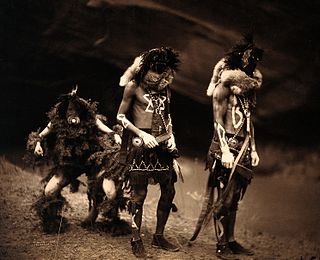
Native American religions are the spiritual practices of the Native Americans in the United States. Ceremonial ways can vary widely and are based on the differing histories and beliefs of individual nations, tribes and bands. Early European explorers describe individual Native American tribes and even small bands as each having their own religious practices. Theology may be monotheistic, polytheistic, henotheistic, animistic, shamanistic, pantheistic or any combination thereof, among others. Traditional beliefs are usually passed down in the forms of oral histories, stories, allegories, and principles.
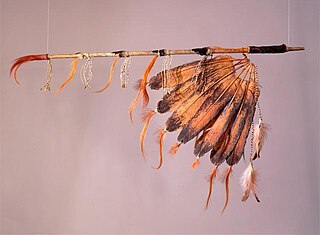
A ceremonial pipe is a particular type of smoking pipe, used by a number of cultures of the indigenous peoples of the Americas in their sacred ceremonies. Traditionally they are used to offer prayers in a religious ceremony, to make a ceremonial commitment, or to seal a covenant or treaty. The pipe ceremony may be a component of a larger ceremony, or held as a sacred ceremony in and of itself. Indigenous peoples of the Americas who use ceremonial pipes have names for them in each culture's Indigenous language. Not all cultures have pipe traditions, and there is no single word for all ceremonial pipes across the hundreds of diverse Native American languages.
Wocekiye. The word is sometimes used to denote the practice of contemporary Lakota Spirituality. The Lakota prefer the word spirituality, as opposed to the practice of religion. Central to this spiritual practice is the mythology of Wakȟáŋ Tȟáŋka, or the Great Mystery. Their primary cultural prophet is Ptesáŋwiŋ, White Buffalo Calf Woman, who came as an intermediary between Wakȟáŋ Tȟáŋka and humankind to teach them how to be good relatives by introducing the Seven Sacred Rites and the čhaŋnúŋpa.

Shaking tent ceremony is a ritual of some of the indigenous people in North America that is used to connect the people with the spirit realm and establish a connection and line of communication between the spirit world and the mortal world. These ceremonies require special tents or lodges to be made, and are performed under the direction of a shaman, or spiritual leader, who uses different practices, rituals, and materials to perform the ceremony. This ceremony is more commonly used by specific indigenous tribes long ago but is still practiced around the continent today.

The modern Medicine Wheel symbol was invented as a teaching tool in about 1972 by Charles Storm, aka Arthur C. Storm, writing under the name Hyemeyohsts Storm. It has since been used by various people to symbolize a variety of concepts, some based on Native American religions, others newly invented and of more New Age orientation. It is also a common symbol in some pan-Indian and twelve-step recovery groups.
References
- 1 2 McGaa, Ed, Rainbow Tribe: Ordinary People Journeying on the Red Road. HarperCollins, 2009.
- 1 2 3 4 Deloria, Philip J., Playing Indian. New Haven: Yale University Press, 1998. ISBN 978-0-300-08067-4. Chapter Six: "Counterculture Indians and the New Age"
- 1 2 3 Huhndorf, Shari Michelle, Going Native: Indians in the American Cultural Imagination. Cornell University Press, 2001. p.164
- 1 2 Native American Stories of the Sacred: Annotated & Explained, 2005- Page xi "One unifying feature of Native American belief is the concept of the "Red Road", though each tribe and nation also has its own name for it. Black Elk speaks of the Red Road in the book The Sacred Pipe."
- 1 2 "Mental Health Essentials in Native Communities: A Guide for Grantees" (PDF). Substance Abuse and Mental Health Services Administration . 2018-05-01. Retrieved 2021-10-29.
It is important to note, while regional practices and language dialects might be similar, each tribe is unique and caution should be used to avoid generalizations.
- 1 2 Children's Medical Center Pediatric Palliative Care Team. "Cultural Approaches to Pediatric Palliative Care in Central Massachusetts: Native American Spirituality". University of Massachusetts Chan Medical School . Retrieved 2021-10-29.
More than 2 million people in 300-500 different American Indian tribal groups, each with its own culture and responses to specific situations. Belief and practices vary widely from tribe to tribe.
- 1 2 "Indigenous spiritual practices". Ontario Human Rights Commission . Retrieved 2021-10-29.
Indigenous peoples practice diverse spiritual traditions in Ontario, reflecting the diversity of Indigenous peoples in Ontario and Canada.
- 1 2 G. Hobson, "The Rise of the White Shaman as a New Version of Cultural Imperialism." in: Hobson, Gary, ed. The Remembered Earth. Albuquerque, NM: Red Earth Press; 1978: 100-108.
- ↑ Neihardt, John G. (1932, William Morrow & Company) Black Elk Speaks
- ↑ Jon Sweeney, "The saint who danced for Queen Victoria," The Tablet, 23 January 2021, 10-11. Sweeney is also author of the book, Nicholas Black Elk: Medicine Man, Catechist, Saint (Liturgical Press, 2020) ISBN 0814644163
- ↑ Petersen, Kirk (2018-08-25). "Vatican considers sainthood for Black Elk". National Catholic Reporter. Retrieved 2021-02-25.
- ↑ DeMallie, Raymond (Nebraska University Press, 1985). The Sixth Grandfather: Black Elk's Teachings Given to John G. Neihardt, ISBN 0803265646. Introduction and notes throughout the book.
- ↑ Carl Silvio Archived 2007-10-07 at the Wayback Machine , Internet Public Library, academic arguments on authorship, translation, and interpretation for prospective audiences have been written by Carl Silvio, among others. Note: This site has been superseded since 2010 by www.ipl2.org, a consortium of universities, accessed 19 June 2011
- ↑ Willis Goth Regier, Masterpieces of American Indian Literature. U of Nebraska Press, 2005, p. 580. ISBN 0-8032-8997-9.
- ↑ Evan T. Pritchard, Native American Stories of the Sacred: Annotated & Explained, Sky Light Illuminations: 2005. Quote: "Black Elk, in The Sacred Pipe, speaks of the Red Road as the north-south cross of the Medicine Wheel, and the east-west cross as the black or blue road, the way we ..."
- ↑ Walker, "A Social Ethical Analysis of BLACK ELK SPEAKS", Southern Methodist University.
- 1 2 RD VICK, LM Smith, CIR Herrera - The healing circle: An alternative path to alcoholism recovery Counseling and Values, 1998 - Wiley Online Library "... Therefore, the incorporation of tribal spiritual teachings and practices into the recovery process can be crucial to its success. Three elements are central to the recovery process: the Sweat Lodge, the Red Road, and the Recovery Medicine Wheel."
- ↑ Aldred, Lisa, "Plastic Shamans and Astroturf Sun Dances: New Age Commercialization of Native American Spirituality" in: The American Indian Quarterly issn.24.3 (2000) pp.329-352. Lincoln: University of Nebraska Press.